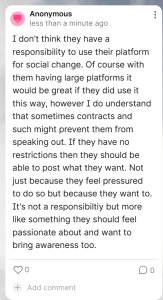3
Navigating this Chapter
[Lecture on Blackboard]
Q & A Padlet
https://padlet.com/kellymcguire/question-and-answer-chapter-three-tkaix4tv1w2noko3
Section One: The Fundamentals
Intro Page: Colonial History and Sport
A) Keywords
https://padlet.com/kellymcguire/keywords-pwffa3u7q0g2zdn8
Exercise 1:
Briefly (in 100 words or less) define one of the keywords in the padlet (including one that you. may have added yourself).
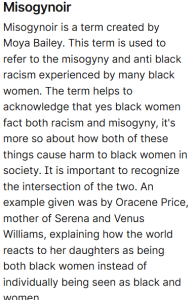 |
B) What is Critical Race Theory?
C) Representing Race
Exercise 2: Notebook Prompt
In about 50-70 words, consider Joel Bervell’s question: why do we feel the need to extrapolate the athleticism of one Black athlete to all Black people when we do not do the same for white athletes?
Try to think of examples when this happens, making sure to reflect on your own positionality.
| Bervell’s question draws attention to the fact that when a black athlete succeeds, we tend to then believe that all black people must all be naturally good at said sport as well. Let’s take Lebron James and Micheal Jordan for example. Their success is sometimes viewed by others as being caused by a natural talent they might have. Due to the success of these great athletes, society then tends to assume that a sport such as basketball is something where a good majority of black people must also be good in, especially when it comes to taller black men as well.
|
D) Gender, Race & Sport
Exercise 3: Notebook Prompt
What are some strategies for resistance that Rajack and Joseph identify in their article as a means of pushing back against and resisting misogynoir?
| Some strategies include setting boundaries, recognizing and calling out microagressions when you see them
Others include highlighting black women in music, film and other forms of media Finally, another way of resisting includes forming safe spaces for black women so that they can speak without their voices being silenced.
|
E) Can Critical Race Theory Save Sports?
Notebook Prompt: Amidst increasing opposition to DEI (diversity, equity, and inclusion) in right-wing American politics, it is interesting to consider Shropshire’s business case for DEI when it comes to sport. What do you think? If you are an ADMN major or simply interested in this question, you are welcome to answer it in place of one of the other prompts in this module.
|
|
F) Sport, Immigration, and Women
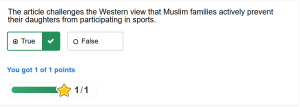
Optional Notebook Prompt:
You may answer this prompt instead of one of the others in this chapter. Do you agree with the findings of this article? According to the authors of this article, how might Muslim women in sport achieve gender justice in sport?
|
|
Section Two: Making Connections
Introductory Page:
A) Athlete Activism
Exercise 3: Padlet Prompt
Do athletes have a responsibility to use their platform for social change? Why or why not? Please remember to record your response in both the padlet below and in your Notebook.
|
|
B) Athlete Activism & Feminism
Exercise 4: Complete the activities
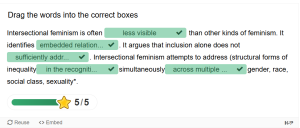
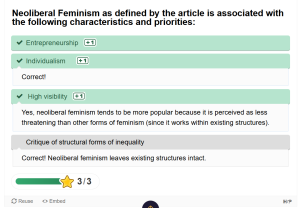
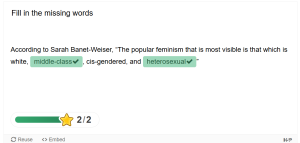
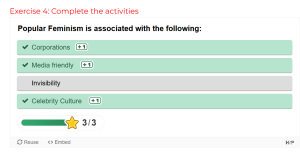
Exercise 5: Notebook Prompt
What do the authors of the article call for as a way of challenging how mainstream sports journalism privileges neoliberal feminist concerns? (100 words max.)
| Cooky and Antunovic call for sports media scholars to tell stories differently. They ask for them to take a different approach, rather than focus on a neoliberal feminist perspective, they should focus on having a more intersectional/ collective feminist approach.
|
C) Corporate social justice
Exercise 6: Padlet Poll
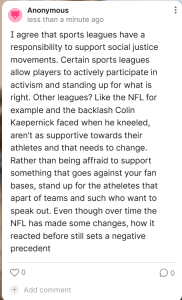
|
Section Three: Taking a shot
Mini Module Assignment (submit as part of notebook through dropbox for Module Three
Exit Poll
These were my contributions:
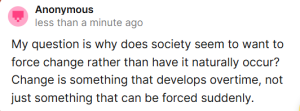
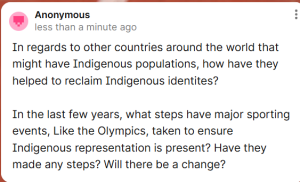
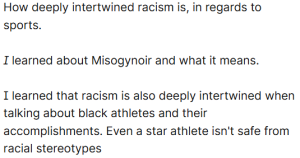
https://padlet.com/kellymcguire/3-2-1-summary-for-chapter-3-sx1c1ywt3qksge6d

